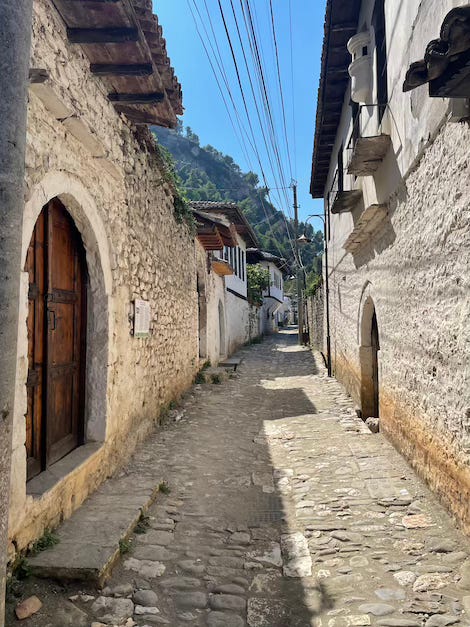Back to ancient times
Quotes of the week
“Athens, the eye of Greece, mother of Arts and eloquence”
John Milton.
“Be afraid of the Greeks bearing gifts”
Virgil.
“We are all Greeks. Our laws, our literature, our religion, our arts have their root in Greece”
Percy Bysshe Shelley, English Romantic Poet.
Hello,
For the first time in a while, I managed to plan my newsletter and hopefully have it published on time. I just hope it works to schedule, even if I am not on the internet. Last week’s letter was from Montenegro, and now we have moved into Albania. Here, a little bit less people, and few traffic congestions which help. We started our tour of the country by going to the mountains. Not my first choice, but we cannot always get what we want. Especially not, when you have a mountain nerd in the family.
Teth
We drove up the serpentine roads to the top of the mountain and down on the other side. The camp area are situated a little up the hill from the valley, so you are surrounded by mountains on all sides. The rule here is that you find a hotel/guest house and ask to camp in the garden. We found a nice hotel with restaurant, and a big field to park our van. We enjoyed a nice dinner at the restaurant and went early to bed.
The next morning Martin prepared to walk up to the pass for a view over to the other side of the mountain. It took him around seven hours to go up and come down again. Nothing for me, in other words. I enjoyed a quiet day with my books. The valley was full of hikers from many different countries. Once Martin was back we had dinner and then started our descent to the city of Shkodër, where there was a nice camping, with a pool, where we stayed for the night.
Durrës, Berat and Apollonia
This was a day with more sightseeing than usual. Durrës is a port city, with a history that goes back 2500 years, with a mix of old and modern buildings. We aimed for the Venetian tower, connected to the old city wall, still visible at certain areas. Close by is a Roman amphitheatre, which we took a glimpse at. Too hot again for any more vivid movements.
Berat met us with temperatures of 38C/100.4F. There was no way to avoid going through this city which life began in the 5th-6th centuries B.C. as an Illyrian settlement. Since 2008 a UNESCO World Heritage site, this cit has a unique style of architecture. Influences from several civilisations has shared the scene for centuries. Within its walls the buildings form a wonderful combination of eastern and western cultures, traditions and outlook. A fortress on top of the mountain is watching over the city.
A slow walk took us through the city which is divided by a river. The houses linger on the mountainsides on either side of it, surrounded by small stone alleys. It is like going into a labyrint, more so on the fortress side of the city. It is sometimes called the city of 1000 windows, since the windows are quite noticeable when you look up the mountainside. In spite of the heat, it was well worth a walk around this quite extraordinary city which has survived rise, decline and has rissen again.
Apollonia was a surprise visit. We followed a brown sign indicating a historical place. Although the place can not be compared to either Greece, nor Rome or North African sites, it still had a silent charm that won you over.
Apollonia was an Ancient Greek trade colony which developed into an independent polis, and later a Roman city, in southern Illyria (today in the county of Fier in Albania). It was founded around 600 B.C. by Ancient Greek colonist from Corinth. Perhaps the most important of the several classical towns with the same name. Its government aimed their efforts towards resource extraction rather than supporting the population. Gradually it gained political independence from Corinth, was organised as a polis under an oligarchic system. Or, like Aristotle put it. “In Apollonia’s oligarchy, a small Greek elite class largely descended from the original colonists ruled over a largely local Illyrian population.” It flourished in the Roman period and from 2nd century B.C. it became an important military place. It also hosted a famous school of philosophy, and became a major center of Greek learning. Even Augustus, the first Roman emperor was one of the many students here. From the 3rd century A.D. it began to decline when an earthquake hit the city and it was abandoned in the next century.
It was not until the beginning of the 20th century that the site was being open for archaeological digs, first by the Austrians, then by the French and later on by the Albanians. The biggest part of the site is still unexcavated. The old Monastery is a museum, well worth a visit. Unusual finds, which seem totally unharmed after all the years in the earth. Outside is a beautiful, Byzantine church. From the museum you walk up a small hill to the amphitheatre, the Forum and the beautiful pillared entrance to the temple. There is a mystic atmosphere as you look down the hill and at the very end see the sea. A quite unexpectedly interesting visit.
That is all for this week, but there will be more to come from Albania.
My blog this week
Due to problems with internet, and travelling all the time, there has not been many blog posts either. I did an August Wrap-up of my reading.








